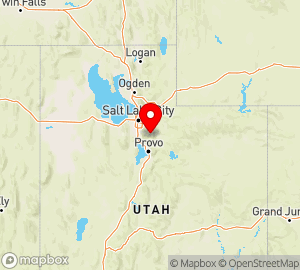Utah
Utah State Information

www.utah.gov
Area (sq mi):: 84898.83 (land 82143.65; water 2755.18) Population per square mile: 30.10
Population 2005: 2,469,585 State rank: 0 Population change: 2000-20005 10.60%; 1990-2000 29.60% Population 2000: 2,233,169 (White 85.30%; Black or African American 0.80%; Hispanic or Latino 9.00%; Asian 1.70%; Other 8.30%). Foreign born: 7.10%. Median age: 27.10
Income 2000: per capita $18,185; median household $45,726; Population below poverty level: 9.40% Personal per capita income (2000-2003): $23,878-$25,407
Unemployment (2004): 5.00% Unemployment change (from 2000): 1.60% Median travel time to work: 21.30 minutes Working outside county of residence: 16.60%
List of Utah counties:
Utah Parks
- US National Parks
- State Parks
- Parks and Conservation-Related Organizations - US
- National Wildlife Refuges
- National Trails
- National Scenic Byways
- National Forests
Utah
Forty-fifth state; admitted on January 4, 1896
State capital: Salt Lake City Nicknames: Beehive State; Salt Lake State; Crossroads of
the West State motto: Industry State animal: Rocky Mountain elk (Cervus canadensis) State bird: California gull (Larus californicus) State cooking pot: Dutch oven State emblem: Beehive State fish: Bonneville cutthroat trout (Salmo clarki) State flower: Sego lily (Calochortus nuttallii) State folk dance: Square dance State fossil: Allosaurus State fruit: Cherry State gem: Topaz State grass: Indian ricegrass (Oryzopsis hymenoides) State historic vegetable: Sugar beet State hymn: “Utah, We Love Thee” State insect: Honeybee (Apis mellifera) State mineral: Copper State rock: Coal State song: “Utah, This Is The Place” State Star: Dubhe State tartan: Utah State Tartan State vegetable: Spanish sweet onion State tree: Blue spruce (Picea pungens)
More about state symbols at:
www.utah.gov/about/symbols.html
More about the state at:
www.utah.gov/about/ pioneer.utah.gov/utah_on_the_web/index.html
SOURCES:
AmerBkDays-2000, p. 21 AnnivHol-2000, p. 4
STATE OFFICES:
State web site: www.utah.gov
Office of the Governor PO Box 142220 Salt Lake City, UT 84114 801-538-1000 fax: 801-538-1528 www.utah.gov/governor
Utah State Library 250 N 1950 West Suite A Salt Lake City, UT 84116 801-715-6777 fax: 801-715-6767 library.utah.gov
Legal Holidays:
| Pioneer Day | Jul 24 |
Utah
a state in the mountainous western part of the USA. Area, 220,000 sq km. Population, 1.2 million (1976), of which 82 percent is urban. The capital and economic center is Salt Lake City.
Most of the state is covered with desert plateaus, including the Great Basin and the Colorado Plateau, which are dissected by the Wasatch, Uinta, and other ranges and by deep ravines. The maximum elevation is 4,123 m. Spurs of the Rocky Mountains are located in the east. The average January temperature varies from – 2° to – 4°C, and the average July temperature varies from 17° to 20°C. Precipitation totals 250–400 mm annually. The chief river is the Colorado, which has several tributaries. The northwestern part of the state has drainage basins with lakes, the largest of which is the Great Salt Lake. Vegetation is mainly of the semidesert and desert types.
Utah’s population is concentrated in oases. The economically active population numbers 470,000 (1975), of whom 14,000 are employed in agriculture, 14,000 in mining, 72,000 in manufacturing, and 28,000 in transportation. Livestock breeding, mainly cattle ranging, accounts for about 75 percent of agriculture production. Sugar beets, alfalfa, and vegetables are grown on the state’s 600,000 hectares of irrigated land. Enterprises in the state extracted 5.5 million tons of petroleum in 1976, as well as substantial amounts of natural gas and coal. Utah is the country’s second largest copper-mining state. Complex ores, gold, and iron and uranium ore are also mined. The leading branches of the manufacturing industry are nonferrous metallurgy (mainly in the Salt Lake City area), ferrous metallurgy (in Geneva, near Provo), oil refining, chemical production, meat packing, sugar refining, and the manufacture of radioelectronics equipment, rockets, and agricultural equipment.
Utah
a freshwater lake in the western USA, in the Great Basin. Utah Lake covers an area of 490 sq km. The lake’s basin is of tectonic origin. The Jordan River flows from Utah Lake and empties into the Great Salt Lake.